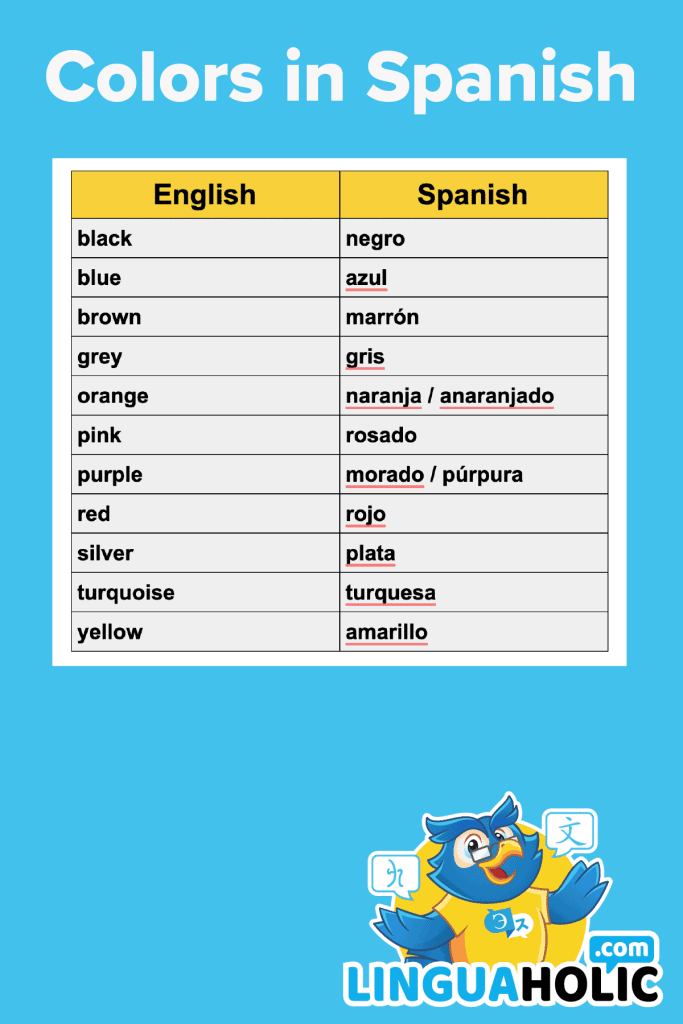Life is full of colors everywhere we go, everywhere we look. Looking to speak Spanish more fluently?
Those interested in learning Spanish know that we love adjectives and giving as much detail as possible to everything we discuss.
Can’t get enough of it!
This coming from a Latina girl makes it even more true. Therefore, knowing your colors and using them appropriately in Spanish is important.
Don’t worry, though; we will guide you through it!

Colors in Spanish
Here’s a list with colors in Spanish:
- Rojo – Red
- Azul – Blue
- Verde – Green
- Amarillo – Yellow
- Naranja – Orange
- Morado – Purple
- Rosa – Pink
- Marrón – Brown
- Negro – Black
- Blanco – White
- Gris – Gray (or Grey)
- Celeste – Sky Blue
- Violeta – Violet
- Índigo – Indigo
- Granate – Maroon
- Dorado – Gold
- Plateado – Silver
- Bronce – Bronze
- Beige – Beige
- Oliva – Olive
- Lavanda – Lavender
- Cian – Cyan
- Turquesa – Turquoise
- Magenta – Magenta
- Melocotón – Peach
Rule #1 – Colors are mainly used as adjectives
Although (depending on the context) colors can be used as nouns, this time, we will focus on the usage of colors as adjectives.
Colors, as any other adjective, follow the basic rules for number and gender.
They must go along with the noun they are describing, therefore let’s recall some important points:
- Number must be correspondent to the noun given. Keep it singular or change it to plural form accordingly. Most times you just need to add an “S” to the word.
- Gender can be feminine or masculine. Most times it is very easy to tell them apart. Feminine nouns and adjectives usually end in “A”, while masculine ones usually end in “O.”
- One more thing: If the adjective ends in a consonant or “E,” it can be used for both feminine and masculine gender! For example, “grande” (big) could be used for “casa grande” (big house – feminine) or “perro grande” (big dog – masculine).
- Special cases apply, as in the case of “mano” (hand). Even though it finishes in “O,” mano is actually a feminine noun! So be careful when using colors with these special cases.
Now, let us have a look at some of the most basic colors in Spanish and how they are put into practice:
Red is for passion – Rojo in Spanish
Red is one of our favorite colors. Symbolizing passion, love, romance, and intensity, there is no wonder we use it to describe even the most abstract concepts.
“Rojo” has a masculine ending by default (as most colors in Spanish), but we can use it for feminine nouns as well. How do we do that? Let’s take a look:
| Singular | Plural | |
| Masculine | El libro rojo | Los libros rojos |
| Feminine | La casa roja | Las casas rojas |
Then, you can also use it in sentences like this:
El libro rojo está en la mesa. (The red book is on the table.)
Los libros de literatura son rojos. (The Literature books are red.)
La casa de Pedro es roja. (Pedro’s house is red.)
La casa roja tiene jardín. (The red house has a garden)
Yellow sunshine – Amarillo in Spanish
For English speakers learning Spanish, “Amarillo” (yellow) is a difficult one to pronounce but a fun one as well.
Symbolizing energy, excitement, and brightness itself, yellow can be very useful to express ourselves in Spanish.
“Amarillo” ends in “O,” so it also has a masculine ending by default, but we can use it for both masculine and feminine nouns as well. See the following examples:
| Singular | Plural | |
| Masculine | El taxi amarillo | Los taxis amarillos |
| Feminine | La mochila amarilla | Las mochilas amarillas |
Then you can also use it in sentences like this:
El taxi amarillo es mío. (The yellow taxi is mine.)
El taxi de Patricia es amarillo. (Patricia’s taxi is red.)
Las mochilas de los niños son amarillas. (The children’s backpacks are yellow.)
La mochila amarilla tiene bolsillos. (The yellow backpack has pockets.)
Don’t be blue! – Azul in Spanish
Blue can be used in many contexts and we use it for an intense dark blue connotation mainly (for light blue, we say “celeste”).
Symbolizing calm, serenity, and formality, blue is a versatile color we use for describing many things.
“Azul” ends with a consonant, which means we can use it indistinctly for both masculine and feminine nouns, too!
But how do we do it in this case? Let’s take a look at the following examples:
| Singular | Plural | |
| Masculine | El lapicero azul | Los lapiceros azules |
| Feminine | La casaca azul | Las casacas azules |
Then, you can also use it in sentences like this:
El lapicero azul está en el cajón. (The blue pen is in the drawer.)
El lapicero de María es azul. (Maria’s pen is blue.)
Las casacas del uniforme son azules. (The uniform’s jackets are blue.)
La casaca azul está en el clóset. (The blue jacket is in the closet.)
One more thing! You surely noticed how we made the plural form of azul by adding “ES” at the end.
That’s because it ends in a consonant. That’s the rule. And yes, it works for either masculine or feminine forms.
They’ll go green for your Spanish! – Verde in Spanish
Where to begin with green? Symbolizing nature, calm, and relaxation, all I can think of is peaceful gardens and a cup of tea!
This color, “verde,” ends in “E,” which, as in the usage of “azul,” means it can be used for both masculine and feminine nouns.
And I know you’re thinking, “These Spanish speakers and their grammar rules!”. But you won’t deny it’s pretty versatile, right? Now, here’s how we use it:
| Singular | Plural | |
| Masculine | El cojín verde | Los cojines verdes |
| Feminine | La lámpara verde | Las lámparas verdes |
Then you can also use it in sentences like this:
El cojín verde está en el sofá. (The green cushion is on the sofa.)
Los cojines de la sala son verdes. (The living room’s cushions are green.)
La casa de Pedro es roja. (Pedro’s house is red.)
La casa roja tiene jardín. (The red house has a garden)
Not the black sheep of the family – Negro in Spanish
Did you know black is not a color? Black is actually the absence of color.
Black is a mysterious one, very dark and full of strength.
Just as with red, Spanish speakers use black to describe very abstract concepts. We just love doing that! “Negro” has a masculine ending by default, as it ends in “O,” but we can use it for feminine nouns as well. Look at these examples:
| Singular | Plural | |
| Masculine | El carro negro | Los carros negros |
| Feminine | La nube negra | Las nubes negras |
Then you can also use it in sentences like this:
El carro negro está en la cochera. (The black car is in the garage.)
El carro de mi hermano es negro. (My brother’s car is black.)
Las nubes en el cielo son negras. (The clouds in the sky are black.)
Las nubes negras están cerca. (The black clouds are nearby.)
The white elephant in Spanish – Blanco in Spanish
White symbolizes peace, serenity, and purity. Totally opposite to the connotations associated with black, white still remains powerful and strong.
“Blanco” as you might have already guessed, works for both feminine and masculine nouns.
Let us have a closer look:
| Singular | Plural | |
| Masculine | El lápiz blanco | Los lápices blancos |
| Feminine | La silla blanca | Las sillas blancas |
Then you can also use it in sentences like this:
El lápiz blanco está en el escritorio. (The white paper is on the desk.)
Los lápices de Mateo son blancos. (Mateo’s pencils are white.)
Las sillas del comedor son blancas. (The dining room’s chairs are white.)
La silla blanca está rota. (The white chair is broken.)
Know your colors – You did it!
Now you are more familiar with everything you need to know about colors in Spanish, from the meaning linked to each one – from a Latin American girl’s perspective, anyway! – to the very important grammar rules of usage regarding gender and number.
Now that you’re a pro, try to use them more often in your sentences.
Hopefully, this has been entertaining and helpful for you to keep learning and using more Spanish. So, give it a go and use those colors in your sentences!
Colors in Spanish – Resources (Infographic & PDF)
If you want to download the list as a PDF document, you can do that here.
And here is a neat little worksheet for all our eager Linguaholics!
Enjoy!

Hi! My name is Pierina Sánchez and I am a Foreign Languages teacher (English-Spanish), foodie, wanna-be fashionista and full time mom. I dedicate my life to helping others learn not just about the language but also the cultural differences between these two beautiful languages. Being Peruvian surely adds up a Latin American perspective, especially to those who want to visit this part of the world.


